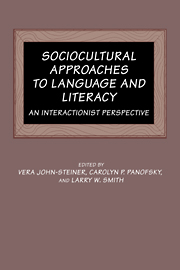Book contents
- Frontmatter
- Contents
- List of contributors
- 1 Introduction
- Part 1 Context
- Part II Mediational processes
- 5 Nonverbal factors in the interpsychic to intrapsychic internalization of objects
- 6 An ecological approach to the emergence of the lexicon: Socializing attention
- 7 Learning how to explain: The effects of mother's language on the child
- 8 Developing the representational functions of language: The role of parent–child book-reading activity
- 9 The implications of Vygotskian theory for the development of home-school programs: A focus on storybook reading
- 10 Vygotsky in the classroom: An interactionist literacy framework in mathematics
- Part III Functional systems
- Author index
- Subject index
8 - Developing the representational functions of language: The role of parent–child book-reading activity
Published online by Cambridge University Press: 05 November 2011
- Frontmatter
- Contents
- List of contributors
- 1 Introduction
- Part 1 Context
- Part II Mediational processes
- 5 Nonverbal factors in the interpsychic to intrapsychic internalization of objects
- 6 An ecological approach to the emergence of the lexicon: Socializing attention
- 7 Learning how to explain: The effects of mother's language on the child
- 8 Developing the representational functions of language: The role of parent–child book-reading activity
- 9 The implications of Vygotskian theory for the development of home-school programs: A focus on storybook reading
- 10 Vygotsky in the classroom: An interactionist literacy framework in mathematics
- Part III Functional systems
- Author index
- Subject index
Summary
It is a commonplace of our educational wisdom that young children should be read to. Not only is this belief widely held in popular thought but within the professional educational community as well (Teale, 1984). Yet it is not sufficient to say that reading to children is a key to literacy. As research (e.g., Heath, 1982, 1983; Wells, 1982, 1985) has shown, not all children who are “read to” at home do well in early literacy instruction.
Critical to the experience of adult–child book reading is the nature of that activity. In her ethnographic study of children from three communities, Heath (1982) found, for example, that when adults looked at books with very young children, all engaged in the kind of pointing-and-naming games, which Ninio and Bruner (1978) referred to as “ritual naming.” However, once children's vocabulary needs diminished, some parents demanded an end to verbal interaction during book reading – children were expected to “be quiet and listen” – while other parents allowed the verbal interaction to remain a part of the activity. In a similar kind of contrastive finding in his longitudinal study, Wells (1985) found no correlation between looking at picture books with later literacy development but did find a significant correlation with the reading of stories and later success.
- Type
- Chapter
- Information
- Sociocultural Approaches to Language and LiteracyAn Interactionist Perspective, pp. 223 - 242Publisher: Cambridge University PressPrint publication year: 1994
- 8
- Cited by



